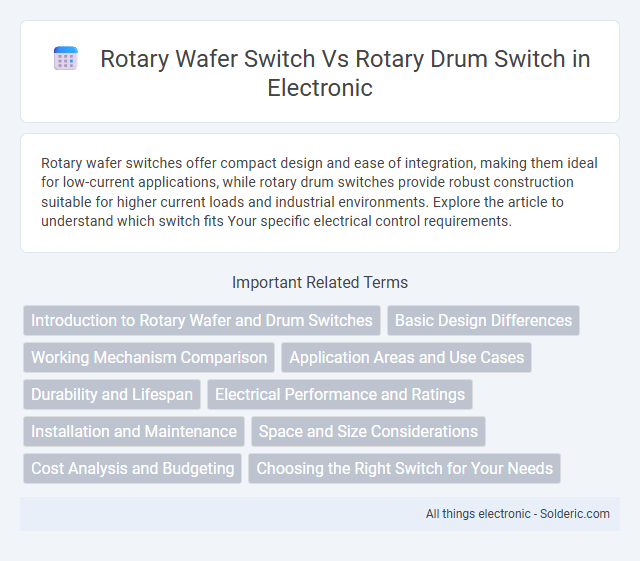Rotary wafer switches offer compact design and ease of integration, making them ideal for low-current applications, while rotary drum switches provide robust construction suitable for higher current loads and industrial environments. Explore the article to understand which switch fits Your specific electrical control requirements.
Comparison Table
| Feature | Rotary Wafer Switch | Rotary Drum Switch |
|---|---|---|
| Design | Compact, layered wafer-type contact plates | Drum-shaped mechanism with rotating cams |
| Application | Low-power circuits, signal switching | High-power circuits, motor control |
| Current Rating | Typically up to 5A | Up to 50A or higher |
| Durability | Moderate, suited for frequent switching | Robust, ideal for heavy-duty switching |
| Contact Type | Metal wafers or plates | Rotating drum with fixed contacts |
| Mounting | Panel mount or PCB mount | Panel mount with mechanical linkage |
| Price | Generally lower cost | Higher cost due to construction |
Introduction to Rotary Wafer and Drum Switches
Rotary wafer switches provide compact, versatile solutions for controlling electrical circuits through a rotating mechanism with stacked wafer layers allowing multiple switching operations. Rotary drum switches utilize a cylindrical drum mechanism to enable robust, multi-position switching in industrial applications, offering high durability and precise control. Both switch types serve key roles in electrical system management, with your choice depending on space constraints and specific operational requirements.
Basic Design Differences
Rotary wafer switches consist of thin, flat wafers stacked on a common spindle, each containing multiple electrical contacts that rotate to create or break circuits. Rotary drum switches feature a cylindrical drum with cam-operated contacts arranged around its circumference, offering robust, high-current handling in a compact design. The wafer switch enables fine, multi-circuit control, whereas the drum switch provides durable, heavy-duty switching for industrial applications.
Working Mechanism Comparison
The rotary wafer switch operates by rotating a disc with conductive segments that align with stationary contacts to open or close circuits, offering precise control in low-voltage applications. In contrast, the rotary drum switch uses a cylindrical drum with embedded contacts that rotate to establish multiple circuit paths, suitable for higher power switching and complex motor control. The wafer switch provides simpler, compact switching, while the drum switch enables robust multi-circuit configurations with enhanced durability.
Application Areas and Use Cases
Rotary wafer switches are commonly used in low-current electronic devices and control panels due to their compact size and precise position control, ideal for selecting electrical circuits or adjusting settings in instrumentation. Rotary drum switches are preferred in industrial machinery and heavy-duty applications, providing robust and reliable operation for motor control, reversing, and speed selection in equipment such as cranes, hoists, and large motors. Both switches are essential in automation and control systems, with wafer switches suited for fine electrical signal management and drum switches optimized for high-power mechanical switching tasks.
Durability and Lifespan
Rotary wafer switches typically offer moderate durability, suited for low to medium current applications, with a lifespan ranging from 10,000 to 20,000 cycles depending on usage conditions. In contrast, rotary drum switches are engineered for heavy-duty industrial use, providing superior durability and an extended lifespan often exceeding 30,000 cycles due to robust construction and enhanced contact mechanisms. The choice between the two depends on the application's current load and environmental factors influencing switch longevity.
Electrical Performance and Ratings
Rotary wafer switches typically offer lower current and voltage ratings, making them suitable for signal-level or low-power applications, often rated up to 10A and 250V. In contrast, rotary drum switches are designed for heavy-duty electrical performance, commonly rated for currents from 20A to over 100A and voltages exceeding 600V, accommodating industrial motor control and power distribution needs. The robust construction of rotary drum switches ensures higher durability under frequent switching and harsh conditions, while rotary wafer switches provide more compact, lightweight solutions for less demanding electrical environments.
Installation and Maintenance
Rotary wafer switches offer a compact design that simplifies installation in tight control panels, requiring minimal wiring adjustments and fewer mounting components compared to rotary drum switches. Maintenance of wafer switches is generally straightforward, with accessible contact plates that reduce downtime and ease replacement. Your choice depends on space constraints and the need for quick serviceability in electrical circuits.
Space and Size Considerations
Rotary wafer switches are compact and lightweight, making them ideal for applications where space is limited and a small profile is essential. In contrast, rotary drum switches typically require more installation space due to their larger, bulkier design and multiple contact points. Choosing between the two depends on your need for saving panel space versus the complexity of switching requirements.
Cost Analysis and Budgeting
Rotary wafer switches generally offer a lower initial cost compared to rotary drum switches due to their simpler design and fewer components, making them suitable for budget-conscious projects. Maintenance expenses for rotary wafer switches tend to be minimal, whereas rotary drum switches might incur higher long-term costs because of their more complex internal mechanisms requiring periodic servicing. When budgeting, consider not only the upfront price but also potential maintenance and replacement costs associated with the specific application requirements and switch durability.
Choosing the Right Switch for Your Needs
Rotary wafer switches offer compact design and precise control, making them ideal for applications requiring limited space and multi-position functionality. Rotary drum switches provide robust construction and high current capacity, suitable for heavy-duty industrial machinery and switchgear. Understanding your specific operational requirements and electrical load will help you choose the right switch to ensure safety, reliability, and optimal performance.
rotary wafer switch vs rotary drum switch Infographic

 solderic.com
solderic.com